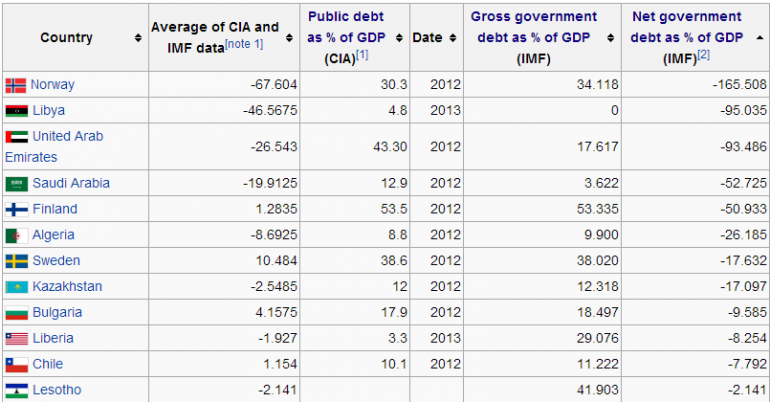Should governments run budget surpluses?
Ask any politician if governments should run surpluses and the answer is likely to be a resounding yes, with the rationale being that governments should “live within their means”.
Precisely this reason was given by the Australian National Commission of Audit, which has been charged by the Abbott government with the task of suggesting ways to rein in government spending. Its first report gave, as the very first of its “principles of good government”, the mantra that governments should:
"Live within your means. All government spending should be assessed on the basis of its long-term cost and effectiveness and the sustainability of the nation’s long-term finances (Executive Summary, National Commission of Audit)."
The analogy behind this principle is that governments are like companies, and should therefore have strong balance sheets:
"For governments, as with companies, a strong balance sheet is important (What should governments do?, National Commission of Audit)."
To achieve this strong balance sheet, the Australian government’s goal is to achieve a surplus equivalent to 1 per cent of GDP within a decade and presumably to maintain it from then on:
"The government’s fiscal strategy stipulates a budget surplus equivalent to 1 per cent of Gross Domestic Product prior to 2023-24 and this is key to our Terms of Reference. The Commission regards this as a prudent and sensible goal. With no further global or domestic shocks, it will allow us to pay down our debt to future-proof the economy against the next crisis (Executive Summary, National Commission of Audit)."
To support this case, the Commission argues that government spending in Australia is out of control:
"Given what we reasonably know about trends in Commonwealth spending, and holding to the cap on tax collections, the ‘Business as Usual’ Scenario would see the Commonwealth’s Budget remain in deficit out to 2023-24 and beyond. If this eventuated Australia’s taxpayers would be exposed to an unprecedented run of 16 consecutive years of deficits, with net debt rising to almost 17 per cent of GDP or $440 billion in today’s terms (The fiscal strategy and outlook, National Commission of Audit)."
OK. If you’re not Australian, I hope that by now you’re going “What? They’re panicking over net government debt of just 17 per cent of GDP in a decade’s time?”
That is a drop in the bucket compared to the net debt levels today of almost all governments worldwide. In fact, only 25 out of over 100 countries have lower debt levels now (Australia being one of them of course), and most of these are either oil exporters (Norway tops that list with minus 165 per cent of GDP -- in other words it has a net positive equity position), or African countries with very small economies and public sectors like Swaziland (8 per cent), Cameroon (15 per cent).
The only non-oil exporting OECD nations with a lower level of net government debt than Australia today (at 12 per cent of GDP) are Finland (-51 per cent) and Sweden (-17 per cent). The US is currently sitting at 88 per cent of GDP, almost seven times the level that Australia’s Commission of Audit regards as a really bad level to be at in a decade’s time.
So the only explanation for the Australian government’s sense of urgency and incredibly low target for government debt must be that really low government debt, and running surpluses all the time, are really good ideas per se, right?
Well, if the analogy that a government is like a corporation, maybe. Corporations do go into debt, of course, but they strive to have positive net equity (a surplus of assets over liabilities) so that when you work out net debt, you should get a negative number which shows that assets exceed liabilities. That applies to the vast majority of companies.
So how many countries are actually in that position? Twelve (see Figure 1).
Figure 1: Countries with negative net debt

The vast majority have negative net equity, starting from the usual suspects (Greece and Japan at over 100 per cent of GDP) but including the US, UK, and even Germany with a net debt level of 82 per cent of GDP (see Figure 2). Australia is in 73rd place on that list at 12 per cent of GDP. The corporate analogy doesn’t seem to be holding up.
Figure 2: The top countries by government debt to GDP

But maybe there’s a negative relationship between economic growth and the level of government debt, where the latter causes the former?
Yeah, right. So argued Reinhart and Rogoff in their warning that economic growth stalled when government debt exceeds 90 per cent of GDP. Unfortunately, their research was shown to be a bag of nonsense, involving not only insane aggregation methods (giving one bad year in New Zealand the same weighting as 19 good ones in the UK) but outright spreadsheet errors (including omitting 25 data points out of 96 thanks to an error in specifying a data range for a formula). When their egregious errors were corrected, government debt levels of 90 per cent were only slightly correlated with slightly lower growth rates, and the causation issue -- did high debt cause low growth, or vice versa? -- was inconclusive.
So if the data doesn’t help, what about theory? Here we strike the left-right divide in economics (with, of course, the possibility that the left and the right are both wrong).
The right argues for what is or was known as expansionary fiscal contraction: that a period of belt-tightening by the public sector will actually stimulate private spending. The IMF was an early proponent of this policy but after it was tried, the evidence led those same economists to argue that it didn’t work: the decline in government spending caused a greater fall in GDP, so that austerity actually made the public debt to GDP outcome worse.
Of course, if you read my column last week, you’d have one additional explanation as to why expansionary fiscal contraction didn’t work. This is because its premise was the sheer nonsense that people would respond to an increase in taxes now by spending more now, because they wouldn’t have to leave as much money to their heirs so that they could pay taxes in the distant future. In 1989, economist Robert Barro wrote:
“A network of intergenerational transfers makes the typical person a part of an extended family that goes on indefinitely. In this setting, households capitalise the entire array of expected future taxes, and thereby plan effectively with an infinite horizon.”
Whether right or left, your position shouldn’t be based on delusional nonsense like that.
That brings me to the left position, represented by mainstream economists like Paul Krugman and non-mainstream group like modern monetary theory economists Randy Wray, Stephanie Kelton, and so on.
Krugman argues for countercyclical fiscal policy -- running deficits during slumps and surpluses during booms -- on the basis of the so-called IS-LM model. MMT economists put a stronger case that the government should run deficits almost always; the only question is how big they should be.
I’ll explore that case with a simulation model next week. But in the meantime, the evidence is that the Australian government’s emergency tone over the scale of Australia’s public debt is a total furphy.
Steve Keen is author of Debunking Economics and the blog Debtwatch and developer of the Minsky software program.
















